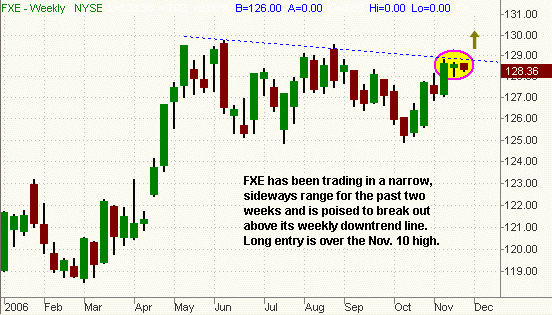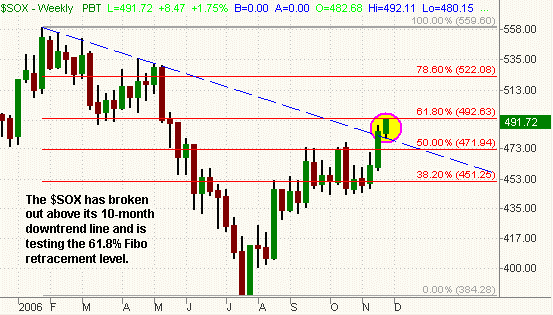As anticipated, the Semiconductor Index ($SOX) broke out above the high of last week's consolidation, pulling the Nasdaq higher as well. Both the Nasdaq Composite and small-cap Russell 2000 gained 0.3%, while the S&P Midcap 400 Index advanced 0.2%. Relative weakness was found in the S&P 500 and Dow Jones Industrial Average, which closed lower by 0.1% and 0.2% respectively. Given that both the S&P and Dow closed higher for six consecutive sessions, yesterday's fractional losses were inconsequential. Selling pressure two hours before the close caused the S&P to finish just below the middle of its intraday range, but the Nasdaq grinded its way back to close in the upper third of its range.
Turnover declined across the board yesterday. In the Nasdaq, total volume was 2% lighter than the previous day's level. Volume in the NYSE declined by 8%. In both exchanges, volume came in below 50-day average levels. With the stock market closed for the Thanksgiving Day holiday on Thursday and a shortened session on Friday, we expect volume to remain lethargic until next week. Since choppy and erratic trading often results from lower than average volume levels, it's an even better reason to be in "SOH mode" (sitting on hands). In the Nasdaq, advancing volume beat declining volume by a margin of 1.9 to 1. Conversely, the NYSE ratio was marginally negative by 1.1 to 1.
Due to recent weakness in the U.S. dollar, the CurrencyShares Euro Trust (FXE) is starting to look pretty bullish. This ETF, which mirrors the price of the Euro vs. the U.S. dollar, has been consolidating in a narrow range for more than a week and is now poised to breakout above its weekly downtrend line from the June 2006 high:

We are stalking FXE for a potential long entry if it rallies above the November 10 high (circled). Since it is already near its 52-week high, it would not take a lot of additional buying pressure to subsequently propel FXE to a new high. There are a handful of other ETFs that mirror the price movements of various currencies versus the U.S. dollar, but FXE is one of the better looking setups. A weak dollar has also been a factor in gold's recent strength. We remain long the StreetTRACKS Gold Trust (GLD) because it is consolidating in a narrow, sideways range above its 20-day MA. It should soon make a run at a fresh high. Both GLD and FXE have a low correlation to the direction of the overall broad market, which is ideal considering we are primarily in "SOH mode" with regard to the stock market.
In yesterday's newsletter, we illustrated how the $SOX index was poised to move above the high of its recent consolidation. Not only did yesterday's 1.8% gain cause it to rally above a three-day sideways range, but the $SOX also broke out above resistance of its weekly downtrend line that began in January 2006. As long as the $SOX remains strong, the Nasdaq will have a tough time going much lower. In case you bought one of the semiconductor ETFs we discussed yesterday, let's take a look at where the $SOX is likely to encounter its next resistance. To do so, we need to apply Fibonacci retracement lines to the longer-term weekly chart:

Looking at the chart above, the dashed blue line marks prior resistance of the primary downtrend line. Since prior resistance becomes new support after the resistance is broken, that descending trendline should now act as support on any pullback in the $SOX. As for the Fibonacci resistance, notice that the $SOX closed right at its 61.8% Fibonacci retracement level. In technical analysis, the 61.8% Fibo retracement is considered to be one of the most pivotal levels because it often acts as a major resistance level that triggers a reversal and continuation of the prior trend. But if the $SOX retraces beyond the 61.8% Fibonacci retracement level, the "last line of defense" is at 78.6% (76.4% is another Fibonacci number that is less commonly used). Beyond that, the odds of it completely retracing all the way to the 100% level and beyond are very high. Since the $SOX just broke out above a 10-month downtrend line, there should be enough follow-through momentum to carry it beyond resistance of its 61.8% retracement level. If long any of the semiconductor ETFs, consider selling into strength as the $SOX approaches its 78.6% retracement at the 522 price level.
Deron Wagner is the Founder and Head Trader of both Morpheus Capital LP, a U.S. hedge fund, and Morpheus Trading Group, a trader education firm launched in 2001 that provides daily technical analysis of the leading ETFs and stocks. For a free trial to the full version of The Wagner Daily or to learn about Wagner's other services, visit MorpheusTrading.com or send an e-mail to deron@morpheustrading.com.